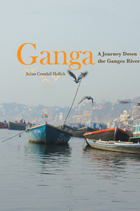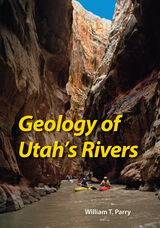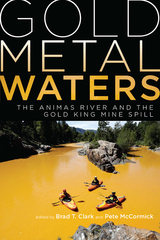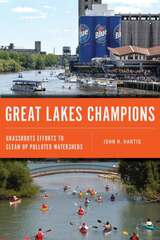127 books about Rivers and 4
start with G
127 books about Rivers and 4
127 books about Rivers
4 start with G start with G
4 start with G start with G

Ganga
A Journey Down the Ganges River
Julian Crandall Hollick
Island Press, 2007
The Ganges has always been more than just an ordinary river. For millions of Indians, she is also a goddess. According to popular belief, bathing in “Mother Ganga” dissolves all sins, drinking her waters cures illness, and dying on her banks ensures freedom from the cycle of death and rebirth.
Yet there remains a paradox: while Ganga is worshipped devotedly, she is also exploited without remorse. Much of her water has been siphoned off for irrigation, toxic chemicals are dumped into her, and dams and barrages have been built on her course, causing immense damage. Ganga is in danger of dying—but if the river dies, will the goddess die too?
The question took journalist Julian Crandall Hollick on an extraordinary journey through northern India: from the river’s source high in the Himalayas, past great cities and poor villages, to lush Saggar Island, where the river finally meets the sea. Along the way he encounters priests and pilgrims, dacoits and dolphins, the fishermen who subsist on the river, and the villagers whose lives have been destroyed by her. He finds that popular devotion to Ganga is stronger and blinder than ever, and it is putting her—and her people—in great risk.
Combining travelogue, science, and history, Ganga is a fascinating portrait of a river and a culture. It will show you India as you have never imagined it.
Yet there remains a paradox: while Ganga is worshipped devotedly, she is also exploited without remorse. Much of her water has been siphoned off for irrigation, toxic chemicals are dumped into her, and dams and barrages have been built on her course, causing immense damage. Ganga is in danger of dying—but if the river dies, will the goddess die too?
The question took journalist Julian Crandall Hollick on an extraordinary journey through northern India: from the river’s source high in the Himalayas, past great cities and poor villages, to lush Saggar Island, where the river finally meets the sea. Along the way he encounters priests and pilgrims, dacoits and dolphins, the fishermen who subsist on the river, and the villagers whose lives have been destroyed by her. He finds that popular devotion to Ganga is stronger and blinder than ever, and it is putting her—and her people—in great risk.
Combining travelogue, science, and history, Ganga is a fascinating portrait of a river and a culture. It will show you India as you have never imagined it.
[more]

Geology of Utah's Rivers
William T Parry
University of Utah Press, 2008
Despite being the second-driest state in the U.S., a substantial portion of Utah’s geologic and cultural history involves rivers, and the effects of flowing water are evident across the state. This book is about the geology of the rivers that shaped Utah’s present landscape, the ancient rivers that left their deposits as a part of the mountains, and the mythical rivers that inspired early exploration.
Parry approaches his subject from many angles—the mountain building events that provide a source for the rivers, the physiographic provinces that give the modern rivers their character, and the deposits of sand and gravel that formed as ancient rivers flowed. Fossil and modern fish fauna are described to provide a unique guide to some aspects of rivers not available by any other method. The description of rivers is completed with the 'historical' account of rivers that did not exist—the mythical rivers of Utah.
Transcending the notion of a traditional geology text, Parry provides detailed commentary on historical exploration and the development of the local scenery. His ambitious scholarship offers a fresh look at Utah’s changing landscape throughout geologic time.
[more]

Gold Metal Waters
The Animas River and the Gold King Mine Spill
Brad T. Clark
University Press of Colorado, 2022
Gold Metal Waters presents a uniquely inter- and transdisciplinary examination into the August 2015 Gold King Mine spill in Silverton, Colorado, when more than three million gallons of subterranean mine water, carrying 880,000 pounds of heavy metals, spilled into a tributary of the Animas River. The book illuminates the ongoing ecological, economic, political, social, and cultural significance of a regional event with far-reaching implications, showing how this natural and technical disaster has affected and continues to affect local and national communities, including Native American reservations, as well as agriculture and wildlife in the region.
This singular event is surveyed and interpreted from multiple diverse perspectives—college professors, students, and scientists and activists from a range of academic and epistemological backgrounds—with each chapter reflecting unique professional and personal experiences. Contributors examine both the context for this event and responses to it, embedding this discussion within the broader context of the tens of thousands of mines leaking pollutants into waterways and soils throughout Colorado and the failure to adequately mitigate the larger ongoing crisis.
The Gold King Mine spill was the catalyst that finally brought Superfund listing to the Silverton area; it was a truly sensational event in many respects. Gold Metal Waters will be of interest to students and scholars in all disciplines, but especially in environmental history, western history, mining history, politics, and communication, as well as general readers concerned with human relationships with the environment.
Contributors: Alane Brown, Brian L. Burke, Karletta Chief, Steven Chischilly, Becky Clausen, Michael A. Dichio, Betty Carter Dorr, Cynthia Dott, Gary Gianniny, David Gonzales, Andrew Gulliford, Lisa Marie Jacobs, Ashley Merchant, Teresa Montoya, Scott W. Roberts, Lorraine L. Taylor, Jack Turner, Keith D. Winchester, Megan C. Wrona, Janene Yazzie
This singular event is surveyed and interpreted from multiple diverse perspectives—college professors, students, and scientists and activists from a range of academic and epistemological backgrounds—with each chapter reflecting unique professional and personal experiences. Contributors examine both the context for this event and responses to it, embedding this discussion within the broader context of the tens of thousands of mines leaking pollutants into waterways and soils throughout Colorado and the failure to adequately mitigate the larger ongoing crisis.
The Gold King Mine spill was the catalyst that finally brought Superfund listing to the Silverton area; it was a truly sensational event in many respects. Gold Metal Waters will be of interest to students and scholars in all disciplines, but especially in environmental history, western history, mining history, politics, and communication, as well as general readers concerned with human relationships with the environment.
Contributors: Alane Brown, Brian L. Burke, Karletta Chief, Steven Chischilly, Becky Clausen, Michael A. Dichio, Betty Carter Dorr, Cynthia Dott, Gary Gianniny, David Gonzales, Andrew Gulliford, Lisa Marie Jacobs, Ashley Merchant, Teresa Montoya, Scott W. Roberts, Lorraine L. Taylor, Jack Turner, Keith D. Winchester, Megan C. Wrona, Janene Yazzie
[more]

Great Lakes Champions
Grassroots Efforts to Clean Up Polluted Watersheds
John H. Hartig
Michigan State University Press, 2022
The Great Lakes—containing one-fifth of the standing freshwater on earth, covering some 94,250 square miles with a combined 10,210 miles of shoreline—have suffered greatly from human use and abuse since the advent of the commercial fur trade in the late 1600s. Logging destroys or degrades habitats, urbanization and industrialization pour human and industrial wastes into the water, fertilizers flowing off farm fields feed algae that suffocate other creatures, and ships bring in exotic species that decimate the lakes’ biodiversity. In 1985 when the International Joint Commission identified more than forty pollution hotspots around the lakes, few people had faith the Areas of Concern would be cleaned up in their lifetime. Indeed, aquatic ecosystem restoration is extremely difficult: only nine of these hotspots have been removed from the infamous list. But progress is being made, and at the helm are local champions, people with a profound love of the region who lead by example and build broad, diverse coalitions in order to realize a common vision. The stories of fourteen of these champions are told here to inspire necessary action to care for the place they call home, so it may be a home to many living creatures for ages yet to come.
[more]
READERS
Browse our collection.
PUBLISHERS
See BiblioVault's publisher services.
STUDENT SERVICES
Files for college accessibility offices.
UChicago Accessibility Resources
home | accessibility | search | about | contact us
BiblioVault ® 2001 - 2024
The University of Chicago Press









